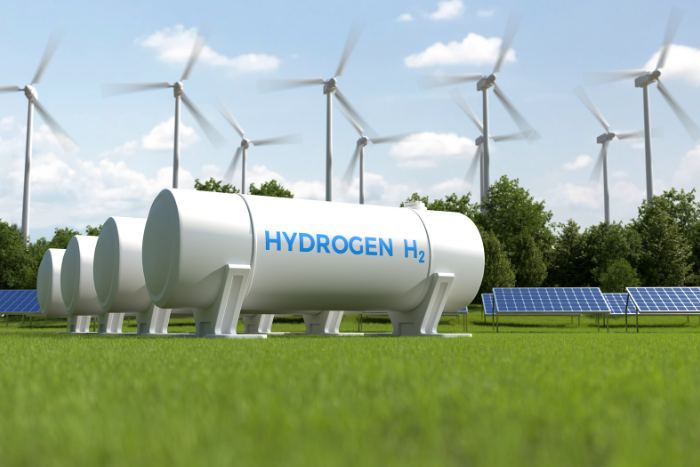India announced the green hydrogen standard including the emission thresholds for production of hydrogen that can be classified as ‘green’. India defined green hydrogen as having a well-to-gate emission of not more than two kg carbon dioxide (CO2) equivalent per kg hydrogen (H2), the ministry said in a statement.
The well-to-gate emission includes water treatment, electrolysis, gas purification, drying and compression of hydrogen, reported the Indian Express. The scope of the definition encompasses both electrolysis-based and biomass-based hydrogen production methods. The ministry of new and renewable energy.will release a detailed methodology for measurement, reporting, monitoring, on-site verification and certification of green hydrogen and its derivatives.
The Bureau of Energy Efficiency (BEE) will be the nodal authority for accreditation of agencies for the monitoring, verification and certification for green hydrogen production projects. India’s National Green Hydrogen Mission aims to produce 5 million metric tonne (MMT) green hydrogen per annum with an associated renewable energy capacity of about 125 giga watt (GW) by 2030.
India to set up green ammonia-based energy storage systems to invite bids
India plans to set up green ammonia-based energy storage systems by floating a technology-agnostic tender, reported Moneycontrol adding that India needs round-the-clock renewable energy for which energy storage is essential. Union Minister for Power and New and Renewable Energy, RK Singh, said soon India will invite bids for using green ammonia as storage. If that works, India’s dependence on lithium-ion batteries for energy storage will be reduced. Recently India introduced bids for battery energy storage systems (BESS) and pumped storage projects (PSPs),
With the government kicking off its ambitious National Green Hydrogen Mission, the production of green ammonia is going to pick up within the next two to three years. Green ammonia is a derivative of green hydrogen, both of which are called “green” when they are produced purely with renewable energy as electricity. At present, ammonia is primarily used in fertilisers not just in India but also across the world.
Renewable energy capacity addition set to rise 33 per cent per annum: CRISIL
Renewable energy capacity will rise by 33 per cent to about 20 gigawatt (GW) per annum over the current and next fiscal years, according to ratings agency CRISIL.
Gurpreet Chatwal managing director, CRISIL Ratings said in the past two fiscals there has been 15 GW per annum capacity addition supported by a healthy executable pipeline of 50 GW (86% solar and 14% wind) of projects as on March 31, 2023.
Capacity has risen due to several factors including the resolution of the Great Indian Bustard (GIB) issue, the deferral of the requirement to procure modules from the Approved Models and Manufacturers (ALMM) list, falling costs of PV modules and simplified access to both debt and equity capital, CRISISL study stated.
Adani gets 2GW SECI manufacturing-linked tender, to set up factory in Mundra
Adani has commissioned a 2 GW solar cell and module factory in Mundra Gujarat, under a manufacturing-linked tender by Solar Energy Corp. of India (SECI). Adani Green Energy secured 8 GW of solar projects under the tender contingent on establishing 2 GW of PV cell and module manufacturing capacity, PV Magazine reported.
Adani Green Energy said that its associate firm, Mundra Solar Energy, obtained commercial operational date certification from SECI for a solar cell and module manufacturing facility with 2 GW of annual capacity. Adani Green Energy holds a 26% stake in Mundra Solar Energy via its wholly owned subsidiary, Adani Renewable Energy Holding Four Ltd.
China to set standards to dismantle and recycle wind turbines and solar panels
To deal with mounting waste China, the world’s biggest renewable equipment manufacturer, will set up a recycling system for ageing wind turbines and solar panels. China targets to bring total wind and solar capacity to 1,200 gigawatts (GW) by 2030, up from 758 GW at the end of last year, but as older projects are replaced and decommissioned, waste volumes are set to soar, with large amounts of capacity already approaching retirement age, reported Climate Home News.
China will release new industrial standards and rules detailing the proper ways to decommission, dismantle and recycle wind and solar facilities, the National Development and Reform Commission, said on Wednesday.
About The Author
You may also like
World, led by China, added 50% more RE capacity in 2023 than in 2022: IEA report
Renewables, not coal, the energy of choice for investors in India for second year in a row: Report
Hope to raise $50 million for solar in next few months; focus on Africa: ISA chief
About 6 lakh new technicians needed globally for wind energy sector by 2027: Report
12% of global growth in solar generation in first half of 2023 came from India: Report


